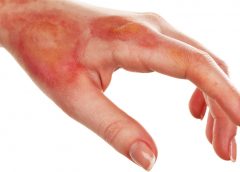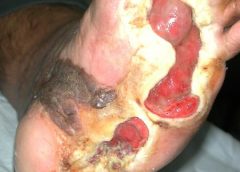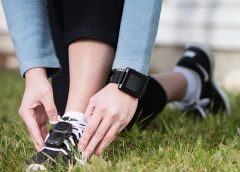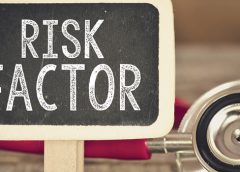BioLab Sciences, an innovator in regenerative medicine technologies, has announced the patent of MyOwn SkinTM, a new, non-evasive, regenerative tissue therapy that uses a patient’s own skin to accelerate the healing of chronic wounds, burns, diabetic foot ulcers and other difficult-to-heal wounds.
Read MoreTag: diabetic foot ulcers
Gene Therapy for Non-Healing Diabetic Foot Ulcers Starts Phase III Trial
Safety and Efficacy Study of VM202 in the Treatment of Chronic Non-Healing Foot Ulcers. This study will assess the safety and efficacy of using gene therapy via intramuscular injections of the calf for patients with chronic non-healing foot ulcers.
The first patient has been dosed in a Phase III trial assessing ViroMed’s VM202, the first pivotal study of a gene therapy indicated for patients with nonhealing diabetic foot ulcers (NHU) and concomitant peripheral artery disease (PAD).
The Phase III trial (NCT02563522) is a double-blind, placebo-controlled, multicenter study designed to evaluate VM202 for safety and efficacy in 300 adults with a diabetic foot ulcer and concomitant PAD. Two hundred patients will be randomized to VM202 and the other 100 to placebo, ViroMed’s U.S. division VM BioPharma said yesterday. (more…)
Read MoreDoctor-turned-businesswoman uses technology to help diabetics save their feet
When Dr. Breanne Everett began training to become a plastic surgeon she was shocked by the number of foot problems, including amputations, she was seeing among diabetic patients. She decided to look for a solution.
That led the 32-year-old physician to put her medical training on hold and make the transition into business and technology.
She invented a device to alert diabetic patients before a sore spot on their foot turned into a wound that could cause severe complications.
The Calgary company she founded — Orpyx — developed pressure-sensitive insole technology to feed information to patients and prevent the kinds of wounds that can lead to amputations in diabetics with peripheral neuropathy, which can cause numbness in the feet.
The company’s smart-sole foot protection system is attracting attention around the world with ongoing clinical trials in both the U.S. and U.K. The product is available through the company, which calls it the only device of its type on the market.
Read more at Ottawa Citizen
Read MoreReduction of 50% in Diabetic Foot Ulcers With Stem Cells
MUNICH — Local injection of mesenchymal stem cells derived from autologous bone marrow shows promise in healing recalcitrant neuropathic diabetic foot ulcers, a novel study from Egypt shows.
Presenting the results at the European Association for the Study of Diabetes (EASD) 2016 Annual Meeting, Ahmed Albehairy, MD, from Mansoura University, Egypt, said: “In patients who received the mesenchymal stem cells, ulcer reduction was found to be significantly higher compared with patients on conventional treatment after both 6 weeks and 12 weeks of follow-up. This is despite the fact that initial ulcer size was larger in the stem-cell–treated group.” (more…)
Read MoreClinical Notes: Moldable Skin Barrier, hypoglycemia, diabetic food ulcers
Moldable skin barrier effective for elderly patients with ostomy
A study in Gastroenterology Nursing reports that compared to a conventional skin barrier, a moldable skin barrier significantly improves self-care satisfaction scores in elderly patients who have a stoma. The moldable skin barrier also caused less irritant dermatitis and the costs for leakage-proof cream were lower.
“The application of a moldable skin barrier in the self-care of elderly ostomy patients” included 104 patients ages 65 to 79 who had a colostomy because of colorectal cancer.
Risk factors for severe hypoglycemia in older adults with diabetes identified
Read MorePros and cons of hydrocolloid dressings for diabetic foot ulcers
Diabetic foot ulcers stem from multiple factors, including peripheral neuropathy, high plantar pressures, decreased vascularity, and impaired wound healing. Contributing significantly to morbidity, they may cause limb loss and death. (See Foot ulcers and diabetes.)
Initially, hydrocolloid dressings were developed to function as part of the stomal flange. Based on their success in protecting peristomal skin, they were introduced gradually into other areas of wound care. They contain wafers of gel-forming polymers, such as gelatin, pectin, and cellulose agents, within a flexible water-resistant outer layer. The wafers absorb wound exudate, forming a gel and creating a moist healing environment. (more…)
Read MoreClinical Notes: Modified Braden Risk Score, dialysis patients, plantar
Modified Braden risk score proposed
A study in Ostomy Wound Management states the risk classification of patients using Braden Scale scores should comprise three (rather than five) levels: high risk, with a total score ≤11; moderate risk, with a total score of 12 to 16; and mild risk, with a total score ≥17.
The retrospective analysis of consecutively admitted patients at risk for pressure ulcer to an acute-care facility included 2,625 patients, with an age range from 1 month to 98 years; 3.1% developed a pressure ulcer. (more…)
Read MoreClinical Notes : Diabetes, medical honey, silver dressings, clostridium
Guidelines for optimal off-loading to prevent diabetic foot ulcers
“The management of diabetic foot ulcers through optimal off-loading,” published in the Journal of the American Podiatric Medical Association, presents consensus guidelines and states the “evidence is clear” that off-loading increases healing of diabetic foot ulcers.
The article calls for increased use of off-loading and notes that “current evidence favors the use of nonremovable casts or fixed ankle walking braces as optimum off-loading modalities.” The authors reviewed about 90 studies. (more…)
Read MoreClinician Resources: Guideline Clearinghouse, Patient Safety, Diabetic Foot-Ulcers
Here are some resources of value to your practice.
National Guideline Clearinghouse
The National Guideline Clearinghouse, supported by the Agency for Healthcare Research and Quality, summarizes many guidelines of interest to wound care, ostomy, and lymphedema clinicians. Here are some examples:
- Guideline for management of wounds in patients with lower-extremity neuropathic disease
- Pressure ulcer prevention and treatment protocol
- Lower limb peripheral arterial disease: diagnosis and management
- Screening for intimate partner violence and abuse of elderly and vulnerable adults: U.S. Preventive Services Task Force recommendation statement.
You can search for guidelines and compare more than one guideline.
Patient Safety Primers
Read MoreWhat you need to know about xerosis in patients with diabetic feet
By Nancy Morgan, RN, BSN, MBA, WOC, WCC, DWC, OMS
Each month, Apple Bites brings you a tool you can apply in your daily practice.
Description
Xerosis, an abnormal dryness of the skin, is one of the most common skin conditions among patients with type 2 diabetes. While assessing for predictors of foot lesions in patients with diabetes, the authors of one study found that 82.1% of these patients had skin with dryness, cracks, or fissures. An unpublished survey of 105 consecutive patients with diabetes revealed that 75% had clinical manifestations of dry skin. (more…)
Read MoreHyperbaric oxygen therapy for treatment of diabetic foot ulcers
By Carrie Carls, BSN, RN, CWOCN, CHRN; Michael Molyneaux, MD; and William Ryan, CHT
Every year, 1.9% of patients with diabetes develop foot ulcers. Of those, 15% to 20% undergo an amputation within 5 years of ulcer onset. During their lifetimes, an estimated 25% of diabetic patients develop a foot ulcer. This article discusses use of hyperbaric oxygen therapy (HBOT) in treating diabetic foot ulcers, presenting several case studies.
HBOT involves intermittent administration of 100% oxygen inhaled at a pressure greater than sea level. It may be given in a:
• multi-place chamber (used to treat multiple patients at the same time), compressed to depth by air as the patient breathes 100% oxygen through a face mask or hood (more…)







